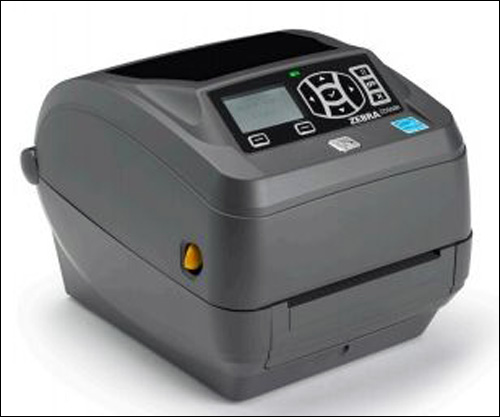Several companies are currently testing a new compact desktop RFID label printer-encoder, smaller than a shoebox and priced at $1,995, that was recently released by Zebra Technologies. The device is designed to be both small and inexpensive, in order to enable businesses to produce a limited number of labels as needed, without having to invest in a large, industrial-size printer. The ZD500R printer-encoder enables retailers, health-care providers and other companies to create labels as needed, in moderate volume—typically, fewer than 500 to 1,000 labels a day.
Retailers commonly receive products from many of their suppliers with EPC ultrahigh-frequency (UHF) RFID labels already attached. Increasingly, these firms are using those tags for inventory tracking, as well as at the point of sale. In some instances, however, labels may be inoperable or missing, or a customer may return an item, leaving the retailer with an exception—an untagged product for sale in the store. Few stores would purchase an industrial-size RFID printer-encoder, which typically costs approximately $4,000 and is designed for high volume and speed. Therefore, they simply work around the exceptions, or encode labels using their handheld readers by first scanning each item’s bar code. The ZD500R is intended to enable store personnel to print and encode labels as required, says Michael Fein, Zebra’s senior product manager, by simply plugging the desktop reader into a power outlet at a counter or on tabletop in the backroom, or at the point of sale.
In the health-care industry, RFID labels are used to track consumables and other medical equipment, as well as for such laboratory items as blood or tissue samples. Although large laboratories utilize RFID labels to monitor specimens moving through the lab setting, few doctors’ offices tag specimens themselves. For doctor’s offices that collect just a handful of samples daily and then send them to the lab, however, the ZD500R is designed to enable to print and encode a label at the time the sample is taken, and thereby provide a lab with a tagged specimen.
The ZD500R measures 7.6 inches wide, 7.5 inches high and 10 inches deep, weighing less than five pounds. It comes with a built-in ThingMagic Mercury 6e Micro-LTE RIFD reader module. The printer-encoder can receive instructions and transmit data via an Ethernet or USB connection, or via a Centronics parallel or RS 232 serial interface, though wireless options (Bluetooth or Wi-Fi) are also available. The device supports both direct thermal and thermal transfer printing, and comes with a cutter designed to accommodate a variety of cutting requirements (based on the size of the label required), thereby helping a user create labels in keeping with the company’s aesthetics. The ZD500R also supports block-permalocking of user memory compatible with ATA Spec 2000.
Each printer-encoder also comes with a built-in passive high-frequency (HF) Near Field Communication (NFC) RFID tag, for a functionality known as “Print Touch,” allowing individuals equipped with an NFC-enabled phone or tablet to tap their reader near the tag. The unique ID number on the tag prompts the phone or tablet to sign into a URL that lists information regarding that printer, such as its specifications and date of manufacture.
The printer also comes with Link-OS, enabling a connection to a cloud-based server via a Wi-Fi, Bluetooth or wired connection. In this way, the company explains, a user could set up a system by which data about each label printing and encoding event is stored on a server, and is thus accessible to company management. This allows the user to bypass the need to integrate software that would manage read data on its own database. Link-OS includes Zebra’s Profile Manager software for managing the population of Zebra printers and printer-encoders, in the event that a company has multiple devices throughout a facility or on multiple sites. Thus, users can view the status of all printers, the number of RFID labels printed and encoded, and each label’s unique ID.
The ZD500R is Zebra’s first printer-encoder to include Link-OS capability. “We think Link-OS is a game changer,” Fein says. With it, he adds, Zebra devices “are not just printers anymore—they are sophisticated network devices.”
The printer also comes with built-in chip-based serialization functionality, for those who wish to use it. This functionality enables users to create unique numbers to be encoded to the tag that employ a formula for uniquely encoding labels with a 38-bit serial number, based on the 35-bit tag identifier (TID) ID number, as well as a three-bit code identifying the chip manufacturer that is already burned onto the chip (see Three RFID Chip Makers Agree on Serialization Approach).
Chip-based serialization can simplify the process of encoding tags, the firm reports, by enabling users to eliminate the need to connect to a server to access software that allocates unique ID numbers.
The desktop printer-encoder can accommodate any standard EPC UHF inlay, Fein says, as long as the label measures between 0.75 inch and 4.25 inches (19 millimeters and 108 millimeters) in width and has a minimum pitch of 0.6 inch (16 millimeters).
To date, the printer-encoder is being used or trialed by numerous retailers and health-care providers, as well as by a variety of other specialty companies, in North America and Europe. For example, a rental car company is using the ZD500R to print and encode RFID labels to monitor vehicles as they enter and leave its facilities, while a government agency is employing the device to create RFID labels for tracking evidence throughout its office and storage areas.



